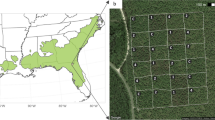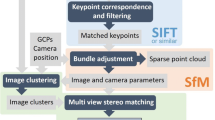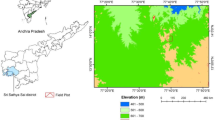Abstract
Forest structure plays a crucial role in maintaining the ecosystem balance. All the biogeochemical cycles need trees for the successful execution of the processes. Nowadays, one of the most critical concerns is the accurate and precise assessment of forest biomass. The biomass assessment can be done by knowing the canopy metrics, stem volume, and specific wood gravity. This research used a terrestrial laser scanner (TLS) to retrieve tree parameters, providing point cloud data (PCD). The parameters derived from PCD are diameter at breast height (DBH) and tree height using randomized Hough transformation (RHT). With these tree parameters, the stem volume of the tree was calculated and correlated with the Forest Survey of India (FSI) equation. The radius, DBH, tree height, and stem volume were also obtained using the Random Sample Consensus (RANSAC) algorithm. The volume calculated using the RANSAC algorithm is statistically analyzed with the volume calculated with the FSI equations available for specific tree species. The R2 value obtained for the volume calculated by the RANSAC and FSI equations is 0.95. In contrast, the correlation value obtained for the volume calculated by RHT and FSI equations is 0.99. Therefore, it shows that both algorithms are highly correlated and can be used as an alternative method for stem volume calculation, which will be less time-consuming and more accurate as well as precise. This method tries to explain the alternative method to calculate tree stem volume without using the species-specific FSI equations, which may sometimes produce biases and uncertainty in calculating stem volume and biomass.












Similar content being viewed by others
References
De Tanago JG, Lau A, Bartholomeus H, Herold M, Avitabile V, Raumonen P, Calders K (2018) Estimation of above- ground biomass of large tropical trees with terrestrial LiDAR. Methods Ecol Evol 9(2):223–234. https://doi.org/10.1111/2041-210X.12904
Gupta V, Reinke KJ, Jones SD, Wallace L, Holden L (2015) Assessing metrics for estimating fire induced change in the forest understorey structure using terrestrial laser scanning. Remote Sens 7(6):8180–8201. https://doi.org/10.3390/rs70608180
Hackenberg J, Morhart C, Sheppard J, Spiecker H, Disney M (2014) Highly accurate tree models derived from terrestrial laser scan data: a method description. Forests 5(5):1069–1105. https://doi.org/10.3390/f5051069
Hackenberg J, Spiecker H, Calders K, Disney M, Raumonen P (2015) SimpleTree—an efficient open-source tool to build tree models from TLS clouds. Forests 6(11):4245–4294
Holopainen M, Kankare V, Vastaranta M, Liang X, Lin Y, Vaaja M, Alho P (2013) Urban Forestry & Urban Greening Tree mapping using airborne, terrestrial and mobile laser scanning – a case study in a heterogeneous urban forest. Urban For Urban Green 12(4):546–553. https://doi.org/10.1016/j.ufug.2013.06.002
Jung S, Kwak D, Park T, Lee W, Yoo S (2011) Estimating crown variables of individual trees using airborne. Remote Sens 3(11):2346–2363. https://doi.org/10.3390/rs3112346
Koma Z, Rutzinger M, Bremer M (2018) Automated segmentation of leaves from deciduous trees in terrestrial laser scanning point clouds. IEEE Geoscience and Remote Sensing Letters 15(9):1456–1460
Liang X, Kankare V, Hyyppä J, Wang Y, Kukko A, Haggrén H et al (2016) Terrestrial laser scanning in forest inventories. ISPRS J Photogramm Remote Sens 115:63–77
Lim K, Treitz P, Wulder M, St-onge B, Flood M (2013) LiDAR remote sensing of forest structure. Prog Phys Geogr: Earth Environ 1(2003):88–106. https://doi.org/10.1191/0309133303pp360ra
Moskal LM, Zheng G, Sensing R, Cooperative PF, Resources F (2012) Retrieving forest inventory variables with terrestrial laser scanning (TLS) in urban heterogeneous forest. Remote Sens 4(1):1–20. https://doi.org/10.3390/rs4010001
Newnham GJ, Armston JD, Calders K, Disney MI, Lovell JL, Schaaf CB, Danson FM (2015) Terrestrial laser scanning for plot-scale forest measurement. Curr For Rep 1(4):239–251. https://doi.org/10.1007/s40725-015-0025-5
Olagoke CP (2015) Extended biomass allometric equations for large mangrove trees from terrestrial LiDAR data. Trees 30(3):935–947. https://doi.org/10.1007/s00468-015-1334-9
Olofsson K, Holmgren J, Olsson H (2014) Tree stem and height measurements using terrestrial laser scanning and the RANSAC algorithm. Remote Sens 6(5):4323–4344. https://doi.org/10.3390/rs6054323
Pueschel P, Newnham G, Rock G, Udelhoven T, Werner W, Hill J (2013) ISPRS Journal of Photogrammetry and Remote Sensing The influence of scan mode and circle fitting on tree stem detection, stem diameter and volume extraction from terrestrial laser scans. ISPRS J Photogramm Remote Sens 77:44–56. https://doi.org/10.1016/j.isprsjprs.2012.12.001
Rudiger Hildebrandt AI (2012) From points to numbers : a database-driven approach to convert terrestrial LiDAR point clouds to tree volumes. Eur J Forest Res 131(6):1857–1867. https://doi.org/10.1007/s10342-012-0638-1
Schnabel R, Wahl R, Klein R (2007) Efficient RANSAC for point-cloud shape detection. Comput Graphics Forum 26(2):214–226
Tittmann P, Shafii S, Hartsough B, Hamann B (2011) Tree detection and delineation from LiDAR point clouds using RANSAC. Proceedings of SilviLaser 1–23
Tran T, Cao V, Laurendeau D (2015) Computers & graphics extraction of cylinders and estimation of their parameters from point clouds. Comput Graph 46:345–357. https://doi.org/10.1016/j.cag.2014.09.027
Wang D, Hollaus M, Puttonen E, Pfeifer N (2016) Fast and robust stem reconstruction in complex environments using terrestrial laser scanning. Int Arch Photogramm Remote Sens Spatial Inf Sci XLI-B3, 411–417. 10.5194/isprs-archives-XLI-B3-411-2016
Xia S, Wang C, Pan F, Xi X, H Z, H L (2015) Detecting stems in dense and homogeneous forest using single-scan TLS. Forests6(11):3923–3945.https://doi.org/10.3390/f6103923
Xu L, Oja E (2009) Randomized hough transform. In Encyclopedia of Artificial Intelligence (pp. 1343–1350). IGI Global
Zhao K, García M, Liu S, Guo Q, Chen G, Zhang X, Meng X (2015) Agricultural and forest meteorology terrestrial LiDAR remote sensing of forests : maximum likelihood estimates of canopy profile, leaf area index, and leaf angle distribution. Agric for Meteorol 209–210:100–113. https://doi.org/10.1016/j.agrformet.2015.03.008
Zheng G, Moskal LM (2012a) International Journal of Applied Earth Observation and Geoinformation Spatial variability of terrestrial laser scanning based leaf area index. Int J Appl Earth Obs Geoinf 19:226–237. https://doi.org/10.1016/j.jag.2012.05.002
Zheng G, Moskal LM (2012b) Leaf orientation retrieval from terrestrial laser scanning (TLS) data. IEEE Trans Geosci Remote Sens 50(2):3970–3979. https://doi.org/10.1109/TGRS.2012.2188533
Zheng G, Moskal LM, Kim S (2013) Retrieval of effective leaf area index in heterogeneous forests with terrestrial laser scanning. IEEE Trans Geosci Remote Sens 51(2):777–786. https://doi.org/10.1109/TGRS.2012.2205003
Acknowledgements
This research was supported by the Indian Institute of Remote Sensing (IIRS)/ISRO, Dehradun, Uttarakhand, India. We would like to thank Dr. Prakash Chauhan, Director of IIRS, for his continuous support and motivation. We thank the Forestry and Ecology Department for providing infrastructure and hardware support.
Author information
Authors and Affiliations
Corresponding author
Ethics declarations
Conflict of interest
The authors declare no competing interests.
Rights and permissions
Springer Nature or its licensor holds exclusive rights to this article under a publishing agreement with the author(s) or other rightsholder(s); author self-archiving of the accepted manuscript version of this article is solely governed by the terms of such publishing agreement and applicable law.
About this article
Cite this article
Singh, A., Kushwaha, S.K.P., Nandy, S. et al. An approach for tree volume estimation using RANSAC and RHT algorithms from TLS dataset. Appl Geomat 14, 785–794 (2022). https://doi.org/10.1007/s12518-022-00471-x
Received:
Accepted:
Published:
Issue Date:
DOI: https://doi.org/10.1007/s12518-022-00471-x




